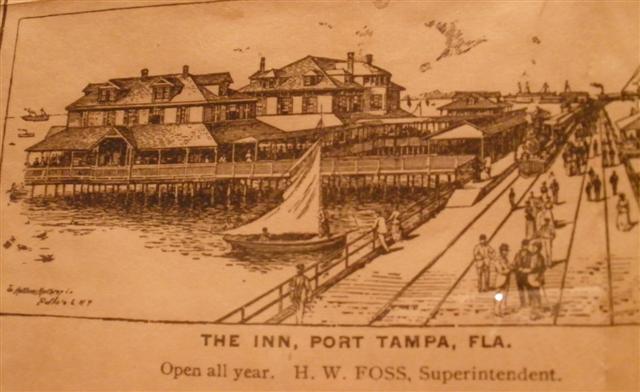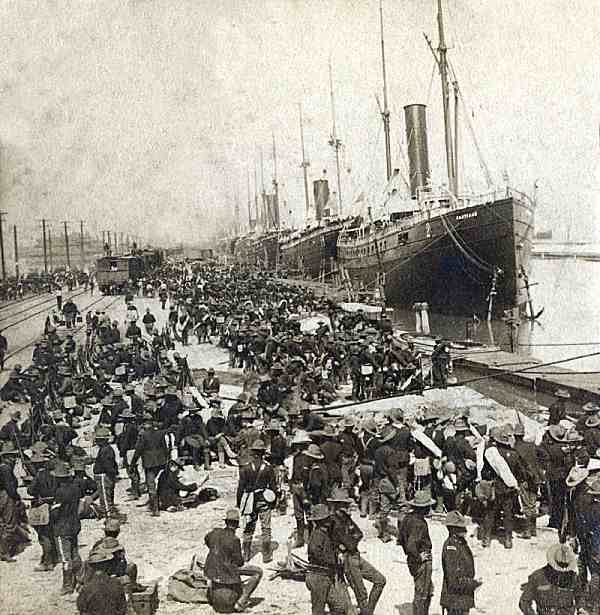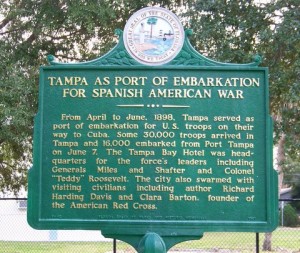
The community which Post 138 serves is still considered “Port Tampa City” which is the southwestern tip of the “Interbay Peninsula” formerly known as “Black Point” in the 1800’s. Port Tampa City remained a chartered municipality until abruptly losing its sovereignty on May 11, 1961 and becoming annexed by the city of Tampa. Today, Port Tampa is a community culturally, ethnically, and socio-economically diverse. It has retained its small town fixtures including civic organizations, fraternal orders, churches, community centers, parks, shops and businesses. Historic sites are repurposed: Port Tampa City Library in the former First Bank of Port Tampa City building, V.T. Clark’s general store in the earlier Hanks’ Corner, American Legion Post #138 on the location of the past Municipal Pier, and West Shore Elementary School on the site of the previous Lottery Building. Ships hauling bulk products and petroleum dock at the port. A freight train rolls along the tracks between Port Tampa and Tampa several times a week. That train whistle is a reminder that this port continues to be an international gateway.
This area was known as a good place for fishing and it still holds that sentiment today. Settlement of the area began around 1885 when Henry B. Plant selected it for his system of hotels, railways and shipping lines. Port Tampa Inn was near H.B. Plant’s newly opened shipping piers and port on the shores of Tampa Bay. Perhaps the most interesting feature of the Port Tampa Inn was that hotel guests could fish from their rooms — the hotel was built on stilts over the bay — and the kitchen staff would prepare their catch and serve it to them in the dining room. ("The Inn, Port Tampa, Fla" photo credit: The Tampa Tribune, “Grand Hotels”, by: Rodney Kite-Powell, published September 18, 2011 and updated July 12, 2013.)
Port expansion led to the development of the City of Port Tampa. Quarters were built for port workers; stately residences were constructed for sea captains; wealthy merchants built grand homes; cigar factory workers built modest dwellings. Port Tampa City became a thriving town and a charter was granted by the state legislature on June 30, 1893; a self-governed borough with elected officials, ordinances, and a marshal to keep the peace.
By the time Clara Barton sailed into Port Tampa from Cuba with injured crewmembers of the USS Maine in April 1898, Henry Plant was successfully lobbying the War Dept. to select Tampa as an assembly point and his docks in Port Tampa as the point of departure for the Spanish-American War – a conflict that would put Tampa on the map. Troops camped in the port district and on Picnic Island. Theodore Roosevelt and the Rough Riders, among other notables, rode through town on their way to the war in June 1898. (Group portrait of Theodore Roosevelt and other high ranking officials of the 1st U.S. Volunteer Cavalry Regiment - Tampa, Florida. 1898.
L-R: 1. Major George Dunn, 2. Major Alexander Brodie, 3. Major General Joseph Wheeler, 4. Chaplain Henry A. Brown, 5. Colonel Leonard Wood, 6. Colonel Theodore "Teddy" Roosevelt who was later 26th U.S. President. - Photo Credit: State Archives of Florida, Florida Memory, http://floridamemory.com/items/show/8697)
Port Tampa was the primary port of embarkation for the Spanish-American War in Cuba. In June 1898 Port Tampa and the city of Tampa hosted more than 33,000 visitors including military officers, enlisted men, nurses, civilian clerks, teamsters, packers, stevedores, war correspondents, tourists, and a host of foreign military observers. Wartime notables who passed through Port Tampa included Teddy Roosevelt and the Rough Riders, the Buffalo Soldiers, Clara Barton of the American Red Cross, Richard Harding Davis, Stephen Crane, and Frederic Remington. (Photo: Spanish-American War - Port Tampa 1898 - Teddy Roosevelt's Rough-riders awaiting embarkation to fight in Cuba. -- Photo credit: Courtesy of the Special Collections Department, University of South Florida. Digitization provided by the USF Libraries Digitization Center.)
Port Tampa became less important when several dredging projects made the Port of Tampa accessible to all shipping. The port is still in use, however, and is the main entry point for fuel for both Tampa International Airport and MacDill Air Force Base.
Photo: Historical Marker -- Photo Credit: CAPT – Civic Association of Port Tampa City, August 24, 2010; “Port Tampa History”; http://port-tampa.info/wp-content/uploads/2011/04/SpanAmWar-300x253.jpg)



View more photo galleries by Post 138 in Port Tampa City, Florida
